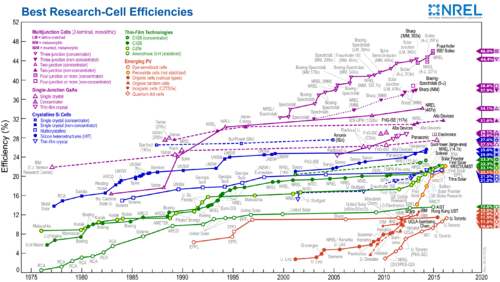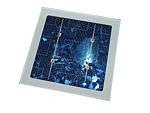Nanocrystal solar cell

Nanocrystal solar cells are solar cells based on a substrate with a coating of nanocrystals. The nanocrystals are typically based on silicon, CdTe or CIGS and the substrates are generally silicon or various organic conductors. Quantum dot solar cells are a variant of this approach, but take advantage of quantum mechanical effects to extract further performance. Dye-sensitized solar cells are another related approach, but in this case the nano-structuring is part of the substrate.
Previous fabrication methods relied on expensive molecular beam epitaxy processes, but colloidal synthesis allows for cheaper manufacture. A thin film of nanocrystals is obtained by a process known as "spin-coating". This involves placing an amount of the quantum dot solution onto a flat substrate, which is then rotated very quickly. The solution spreads out uniformly, and the substrate is spun until the required thickness is achieved.
Quantum dot based photovoltaic cells based on dye-sensitized colloidal TiO2 films were investigated in 1991[1] and were found to exhibit promising efficiency of converting incident light energy to electrical energy, and to be incredibly encouraging due to the low cost of materials used. A single-nanocrystal (channel) architecture in which an array of single particles between the electrodes, each separated by ~1 exciton diffusion length, was proposed to improve the device efficiency[2] and research on this type of solar cell is being conducted by groups at Stanford, Berkeley and the University of Tokyo.
Although research is still in its infancy, in the future nanocrystal photovoltaics may offer advantages such as flexibility (quantum dot-polymer composite photovoltaics[3]) lower costs, clean power generation[4] and an efficiency of 65%,[5] compared to around 20 to 25% for first-generation, crystalline silicon-based photovoltaics.[6]
It is argued that many measurements of the efficiency of the nanocrystal solar cell are incorrect and that nanocrystal solar cells are not suitable for large scale manufacturing.[7]
Recent research has experimented with lead selenide (PbSe) semiconductor, as well as with cadmium telluride photovoltaics (CdTe), which has already been well established in the production of second-generation thin film solar cells. Other materials are being researched as well.
Other third generation solar cells
See also
References
- ↑ B. O’Regan and M. Gratzel, (1991). "A low-cost, high efficiency solar cell based on dye-sensitized colloidal TiO2 films". Nature. 353 (353): 737–740. Bibcode:1991Natur.353..737O. doi:10.1038/353737a0.
- ↑ J.S. Salafsky (2001). "A 'channel' design using single, semiconductor nanocrystals for efficient (opto)electronic devices films". Solid-State Electronics. 45 (1): 53–58. Bibcode:2001SSEle..45...53S. doi:10.1016/S0038-1101(00)00193-3.
- ↑ D.S. Ginger & N.C. Greenham, (1999). "Photoinduced electron transfer from conjugated polymers to CdSe nanocrystals". Physical Review B. 59 (16): 10622. Bibcode:1999PhRvB..5910622G. doi:10.1103/PhysRevB.59.10622.
- ↑ Ilan Gur, Neil A. Fromer, Michael L. Geier, and A. Paul Alivisatos, (2005). "Air-Stable All-Inorganic Nanocrystal Solar Cells Processed from Solution". Science. 310 (5745): 462–465. Bibcode:2005Sci...310..462G. doi:10.1126/science.1117908. PMID 16239470.
- ↑ Quantum Dots May Boost Photovoltaic Efficiency To 65%, 24 May 2005
- ↑ "Photovoltaics Report". Fraunhofer ISE. 28 July 2014. p. 6. Archived from the original (PDF) on 31 August 2014. Retrieved 31 August 2014.
- ↑ N. Gupta, G. F. Alapatt, R. Podila, R. Singh, K.F. Poole, (2009). "Prospects of Nanostructure-Based Solar Cells for Manufacturing Future Generations of Photovoltaic Modules". International Journal of Photoenergy. 2009: 1. doi:10.1155/2009/154059.
External links
- Science News Online, Quantum-Dots Leap: Tapping tiny crystals' inexplicable light-harvesting talent, June 3, 2006.
- InformationWeek, Nanocrystal Discovery Has Solar Cell Potential, January 6, 2006.
- Berkeley Lab, Berkeley Lab Air-stable Inorganic Nanocrystal Solar Cells Processed from Solution, 2005.
- ScienceDaily, Sunny Future For Nanocrystal Solar Cells, October 23, 2005.
